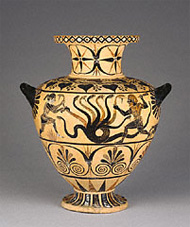Take your students on a journey into the ancient world at the J. Paul Getty Museum at the Getty Villa. Six activities allow students to travel through time, meet a variety of people, and take home a souvenir. They will practice writing about, observing, and drawing works of ancient art. |
 |
 |
1. For each of the in-gallery activities you plan to have your students complete, do the pre-visit introductions described in the Activity Descriptions below.
2. Review the six activities and choose galleries you would like student groups to visit. Choose three to four activities for your class. You may use the Sample Villa Itinerary (see Materials, above), or choose galleries you saw during your Getty Villa Teacher Orientation Workshop. Students will choose different artworks and Villa spaces on their own to write about or draw.
3. Use the Villa Itinerary sheet to create itineraries for your students. Each chaperoned group will do four of the six activities in a different order. Every group will do "Write a Postcard" last. You can delete or adapt the activities if you need to.
4. Print out and make photocopies of activity sheets for each student.
Activity Descriptions:
Journey Through Time
In-Gallery Activity: Students look closely at a work of ancient art by imagining they are a character in the scene depicted and answering questions about what they would see and feel.
Pre-Visit: Make A Scene!—Show students an image of the Mosaic Floor with a Boxing Scene or the Sarcophagus with Scenes from the Life of Achilles. Have them write bubble scripts for each character in the scene. Student actors can then assume the positions of each character and recite the words the class wrote for them. Extend the activity by having the students write a scene to follow the one depicted in the artwork.
Ancient Spaces
In-Gallery Activity: Students pick a space in the Villa, such as a garden or a gallery, and write a travel-log entry describing what they would see, hear, feel, smell, and taste if they were an ancient visitor to that place. Students speculate how ancient and modern spaces in a house might be different and the same.
Pre-Visit: Be An Ancient Roman—As a class, view the Getty Villa introductory film, available in the Visit section of this Web site. As a class, have the students brainstorm what they might see, hear, smell, taste, and feel if they were an ancient Roman child living in a villa.
Place Poem
In-Gallery Activity: Students select a work of art in the Villa galleries and follow writing prompts to create an original place poem about a work of ancient art and the scene it depicts.
Pre-Visit: Poetry Practice—Discuss what "title," "action," "simile," and "description" mean when used in poetry. Show one of the following works of art to the students:
• Statuette of a Griffin Devouring an Arimasp
• Gravestone of Philoxenos and Philoumene
Have students write a short poem about the artwork. Students can practice filling out the activity sheet provided for the in-gallery activity in preparation for choosing their own work of art to examine during their Villa visit.
View a Place Poem activity sample. (PDF - 129KB)
Find a Souvenir
In-Gallery Activity: Students sketch a work of art that they would like to have at home. They can do a detail sketch or a whole-object drawing.
Pre-Visit: Details, Details!—Explain what a "detail" view of an object is by investigating the following examples:
• Storage Jar with Herakles and Apollo Fighting over the Tripod
• Shield Strap with Mythological Scenes
• Pitcher with Water Birds, Dogs, and Ruminants
Have students make quick sketches of a detail they see on the pitcher, then have the class view the drawings to determine where in the artwork each detail can be found.
News Flash!
In-Gallery Activity: Students pretend they are newspaper reporters who have come upon a scene in a work of ancient art. They write their own News Flash! for tomorrow's paper, describing the "who, what, where, when, and why" of the scene.
Pre-Visit: "Another Monstrous Victory for Herakles!"—As preparation for their role as a Villa reporter, show an image of the Water Jar by the Eagle Painter to your students and have them briefly try to identify what is happening in the scene where Herakles battles the Lernaean Hydra, a fierce, nine-headed monster. Read aloud the pre-visit example "News Flash!" (PDF - 257KB). Discuss the "who, what, where, when, and why" of the scene.
Write a Postcard
In-Gallery Activity: Students write a postcard to a friend or family member, telling them about their favorite work of art at the Getty Villa.
Pre-Visit: Villa Top 18, One for Every Gallery!— Show students the Villa Top 18—objects from the Villa galleries that inspire close looking. Have the class vote for their top five favorites and make a bonus scavenger hunt activity especially for your class with the artworks. Use Getty Bookmarks to make a map showing the location of the five objects at the Villa, which you can print out for your chaperone groups to use while at the Villa.
|
 |
 |
 |
| Water Jar, attributed to the Eagle Painter, about 525 B.C. |
 |
|



